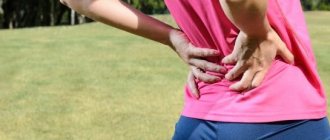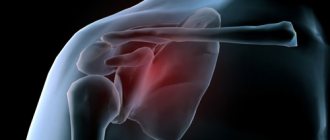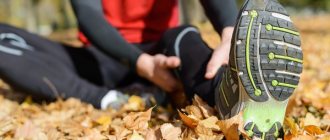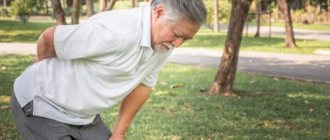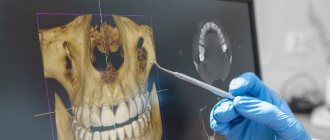Pain syndrome accompanies many diseases. There is a common misconception that shingles pain in the back occurs only with diseases and injuries of the spine. However, experienced rheumatologists and therapists draw patients’ attention to the fact that the cause of pain may be diseases of the internal organs. Specialists at the Yusupov Multidisciplinary Hospital provide daily medical care to patients experiencing this symptom. Comprehensive treatment programs are based on highly accurate diagnostic data, which increases the effectiveness of the chosen therapy.
Shingles in the back: causes
Girdle pain in the abdomen and back is most intense; it can be short-term or long-lasting, depending on the causes of development. It is difficult to independently determine the cause of pain, since the appearance of this symptom can occur due to various disorders:
- Spinal diseases are characterized by increased pain when moving. As the pathological process progresses, other symptoms appear: numbness, increased sweating, tingling and burning in the affected area. In addition, these signs may indicate compression of the nerve roots;
- intercostal neuralgia appears with injuries, prolonged stay in a stationary position, or muscle strain. With this disease, the girdle pain is localized under the ribs or between them, so breathing is difficult;
- lung diseases, which are accompanied by fever, cyanosis of the skin. Diseases such as pneumonia and pulmonary tuberculosis can cause serious consequences if left untreated;
- urolithiasis disease;
- ectopic pregnancy;
- heart attack;
- diseases of the digestive system, characterized by pain under the ribs; this symptom can be combined with nausea, vomiting and fever.
If you have back pain, you need to consult a general practitioner who will examine the manifestations of the pathological condition and prescribe diagnostic measures. The multidisciplinary Yusupov Hospital employs experienced rheumatologists, who are most often approached for help by patients experiencing shingles pain in the back. Specialists are ready to develop an individual treatment program for each patient and begin its implementation after receiving consent from the patient.
Treatment
Help before diagnosis
If epigastric pain suddenly appears, you should not take painkillers before visiting a doctor, so as not to blur the clinical picture. If a chronic gastrointestinal disease is diagnosed, to reduce pain it is necessary to adhere to dietary recommendations and avoid provoking factors. In case of food poisoning, you need to rinse your stomach and use sorbents.
Conservative therapy
Treatment begins with non-drug measures: diet therapy, normalization of the daily routine and abandonment of bad habits, elimination of risk factors for the underlying disease. Medicines are selected only after a full diagnosis and identification of the root cause of the pain syndrome. The main groups of medications that are prescribed for pain in the upper abdomen:
- Painkillers
. In the absence of medicinal gastropathy, medications from the group of non-steroidal anti-inflammatory drugs are used to relieve pain. They are supplemented with antispasmodics and prokinetics, which normalize gastrointestinal motility and eliminate discomfort. - Enzymes.
Preparations of gastric juice and digestive enzymes are used for pain caused by malabsorption and maldigestion. Their long-term use improves a person’s well-being and eliminates symptoms of nutritional deficiency. - Antisecretory agents
. Drugs that reduce the acidity of gastric secretions quickly eliminate pain caused by hyperacidity. They promote the healing of defects in the gastric mucosa. - Antibiotics
. Specific three- and four-component regimens with antibacterial drugs are indicated for the eradication of H. pylori. Antibiotics are recommended for bacterial pneumonia and pleurisy, exacerbation of cholecystitis.
Girdle pain in the abdomen and back
Synchronous pain in the back and abdomen is a dangerous symptom, as it occurs rarely. Pain in the abdomen and back at the same time can indicate diseases of the digestive system, for example, with a peptic ulcer, it appears after eating and is accompanied by nausea and vomiting. Unbearable pain in the abdomen and back is observed during exacerbation of pancreatitis; pain can spread to the area of the shoulder blades or heart.
Inflammation of the appendix can occur suddenly; the pathological process is indicated by symptoms such as nausea, a slight increase in temperature, diarrhea and pain that simultaneously appears in the abdomen and back. The danger of appendicitis is that when the appendix ruptures, peritonitis can occur, so only surgical treatment is performed.
Simultaneous pain in the back and abdomen in women is observed with gynecological diseases:
- ectopic pregnancy;
- development of fibroids;
- endometrial proliferation;
- twisting of the legs of a cyst or fibroids;
- spontaneous termination of pregnancy.
Pain syndrome is also observed in women after childbirth. The localization of pain in the back and abdomen is explained by the fact that during labor the muscles experience severe strain.
Patients seeking help at the Yusupov Hospital can be confident that specialists will accurately determine the cause of the pain syndrome and select the most effective and safe methods to eliminate the problem.
Diagnostics
During a physical examination, the doctor determines areas of hyperesthesia and performs superficial and deep palpation of the epigastric zone. The variety of causes of pain in the upper abdomen requires the gastroenterologist to use a whole range of laboratory and instrumental methods. The most informative tests for diagnosis are:
- Ultrasound of the abdominal cavity.
A simple and non-invasive method that detects signs of inflammatory processes, ulcerative defects and neoplasms in the epigastrium. Using ultrasound, the doctor evaluates the anatomical and functional features of the gastrointestinal tract, confirms or excludes typical diseases (calculous cholecystitis, pancreatitis, hernia). - X-ray methods.
A survey radiograph is not very informative, so radiography with oral contrast is used for examination. The study is necessary to detect ulcerative defects, pyloric stenosis, and diaphragmatic hernia. Using this method, the motor function of the gastrointestinal tract is assessed. - EFGDS.
The most informative method that allows you to visualize inflammatory and erosive changes in the walls of the esophagus, stomach and duodenum. EGD with biopsy is used for the differential diagnosis of ulcers, benign and malignant neoplasms of the gastric zone. - Laboratory methods
. The standard complex includes clinical blood and urine tests, coprogram, and glucose level measurement. To identify gastritis and peptic ulcers, a study of gastric juice and a rapid urease test for H. pylori are informative. To exclude chronic bleeding from the gastrointestinal tract, the Gregersen reaction is performed. - Additional Research
. To confirm the diagnosis of hyperacid gastritis, intragastric pH-metry is required. The functional abilities of the stomach are assessed using electrogastrography and radionuclide scintigraphy. A CT scan is performed for detailed visualization of the abdominal organs.
In case of sharp pain reminiscent of the symptoms of an “acute abdomen”, the patient must be examined by a surgeon. If extra-abdominal processes are suspected, consultations with specialized specialists are prescribed: cardiologist, pulmonologist, neurologist. Patients with suspected psychogenic causes of epigastric pain should be examined by a psychiatrist.
Gastroscopy
Ways to identify the causes of girdle pain
Modern diagnostic methods make it possible to determine the cause of pain localized in the back and under the ribs. When patients who have experienced back pain come to the Yusupov Hospital, the existing symptoms are studied, after which an examination is prescribed.
The main diagnostic measures for back pain are:
- urine and blood tests. The Yusupov Hospital has its own laboratory, so the results are delivered to the attending physician in the shortest possible time;
- Ultrasound of internal organs to detect pathological changes;
- examination of substances discharged from the lungs to exclude diseases of the respiratory system;
- X-ray of the upper limbs and lungs;
- gastroscopy.
Patients may be referred for additional consultation to other specialists at the Yusupov Hospital, a cardiologist, a neurologist, or a rheumatologist. Self-medication for back pain can provoke serious consequences, since without special equipment and knowledge it is impossible to accurately identify the cause of the disease and its manifestations.
Classification of pain, pain of different localizations
The most common are acute pains radiating to the back and ribs.
They are temporary. Only in 10-20% do they develop into a chronic form. Based on localization, pain is divided into: in the lumbar region. Typical for older people. They appear after long walks or excessive stress;
radiating to the back and ribs on the right. It primarily indicates the presence of an inflammatory process;
radiating to the back and ribs on the left. Appears both under load and when stationary. Especially often after a hard day at work or a long trip.
Regardless of where the pain appears, maximum attention should be given to this problem. It is recommended to listen to your own body in order to get rid of unpleasant sensations by eliminating the true cause of the pain. And there are many of them: from banal overwork to disruption of the functioning of internal organs.
High-quality treatment for pain in the back and under the ribs
Specialists at the Yusupov Hospital prescribe comprehensive treatment to eliminate the girdle pain under the ribs and in the back, as well as possible disorders. For some diseases, the patient needs emergency care, which specialists from the Yusupov Multidisciplinary Hospital are ready to provide. Round-the-clock operation of clinics allows diagnosis and hospitalization immediately after treatment.
Medicines are used to treat pain and its causes. Experts draw the attention of patients to the fact that painkillers and medications to relieve spasms have a temporary effect, in addition, they can complicate diagnosis. To eliminate pain, medications in the form of ointments, injections and tablets can be used.
If the patient’s health and life are in danger, surgeons at the Yusupov Hospital can perform surgical intervention. With this method of treatment, experts prefer minimally invasive techniques, after which recovery occurs faster.
Shingles in the back can appear due to insufficient physical activity; rheumatologists recommend leading an active lifestyle, observing personal hygiene rules, and also paying attention to the psychological state to prevent diseases. The Yusupov Hospital employs specialists who develop nutrition programs taking into account the client’s taste preferences.
At the Yusupov Hospital you can receive a wide range of medical services. Specialists pay attention to each patient and accompany him during the treatment process and make the necessary adjustments. If you are concerned about pain in the back area, do not delay visiting a specialist. An appointment with a general practitioner and other specialists can be made by calling the Yusupov Hospital.
Treatment of pain under the ribs
As a rule, in case of severe pain, the doctor uses various painkillers - they can be taken in the form of tablets or administered parenterally. Unbearable pain, which can also occur with intercostal neuralgia, is relieved by novocaine blockade in the area of compression of the nerve roots.
Each identified pathology has its own specific means for treatment. In vertebrology, chest pain caused by thoracic or cervicothoracic osteochondrosis has its own treatment features:
- Drug treatment includes analgesics, anti-inflammatory drugs, muscle relaxants, mild diuretics, drugs to improve peripheral circulation, chondroprotectors, vitamin and mineral complexes;
- Manual therapy, therapeutic exercises, physiotherapy act directly on the causative factor of the pathology, helping to release muscle-joint blocks, strengthen and develop the muscles around the spine, improve blood supply and trophism of the thoracic spine;
- Other types of treatment include prescribing rest during the acute period, a diet with a predominance of proteins, dairy products, vegetables, fruits with the exclusion of grapes, sorrel, coffee, carbonated drinks, sweets, and fatty foods from the diet. In addition, patients can use acupuncture, stone therapy and other methods in complex treatment.


